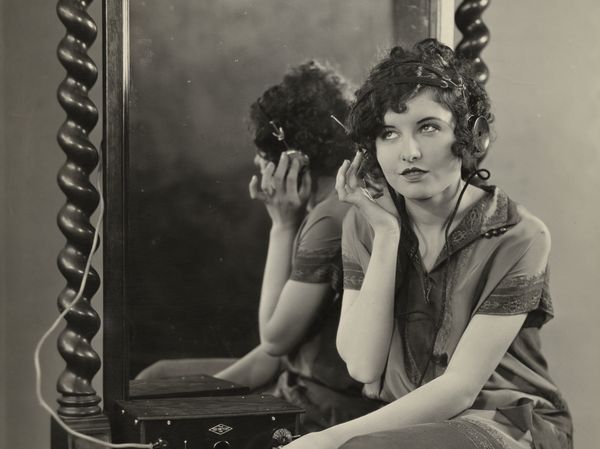HUSBANDS AND LOVERS
John M. Stahl (US 1924)
Husbands and Lovers was Stahl’s second film in a row on the theme of divorce and remarriage, following Why Men Leave Home. Both feature actor Lewis Stone, who would make a total of six films for Stahl, as the once and future husband. Here he embodies a particularly scathing portrait of male solipsism and insensitivity, a subject that Stahl would return to in some of his finest early talkie dramas, such as Seed (1931), Back Street (1932), and Only Yesterday (1933). A subject that veers towards tragedy in those films is mostly played for laughs here, but with a keen eye for subtle details of behavior and some fine cinematic grace notes.
This was the last story credit of Stahl’s wife Frances Irene Reels before her death in 1926, adapted by his frequent collaborator A.P. Younger. The film opens with a long, detailed scene that establishes the nature of the central couple’s marriage through their morning routine, which involves the wife, played by Florence Vidor, waiting on her husband hand and foot, only to be rewarded with insulting criticisms of her appearance. She responds by going out for a makeover and a fashionable new wardrobe, which earns her no points with her husbands but does attract the attention of their lecherous friend, played by Lew Cody.
Vidor is a perfect interpreter of Stahl’s restrained, elegant, yet dryly amused style, though this was the only time he directed her. A popular and admired leading lady in the late 1910s and 1920s, she retired with the coming of sound, and of her silent films only a few are still watched today – one being Ernst Lubitsch’s The Marriage Circle (1924), to which Husbands and Lovers was compared by several reviewers on its release. Lewis Stone had similar qualities of reserve, easy expressiveness, and humor, and he is able in a few extended close-ups to gain some sympathy for a character who, as written, evokes none. He is also helped by the casting of Lew Cody as his rival. Cody specialized in playing smooth cads and lounge lizards; he has “other man” embroidered on him like a monogram, and a reptilian face that betrays little feeling. Still, his character hardly deserves the cruel humiliation to which he is subjected in the film’s climactic scene.
The centerpiece of the film is a scene of mistaken identity, a twist that might be hard to swallow if it were not staged with such beautiful and assured style. Vidor sits by a window, with bars of light falling through shutter-slats and slanting across her, a lovely half-lit image that distills the ambivalence of her character. Stone stands almost completely concealed by darkness, with just a crescent of light tracing one side of his face; he advances into the light and then retreats back into the shadow, like the moon waxing and waning, as he listens silently to his wife’s confession of love for another man. Cinematographer Tony Gaudio, who masterminds the extremely low lighting in this scene, would go on to an illustrious career at Warner Brothers, shooting classics such as Little Caesar, High Sierra, The Letter, and The Adventures of Robin Hood.
Gaining popularity at a time when divorce was only just becoming more socially acceptable, remarriage dramas seem driven by conflicting desires to critique and affirm marriage, to flirt with being “modern” about adultery and women’s autonomy, and yet to ensure a final retreat back into the romantic conventions of happily-ever-after. These films made comedy out of the battle of the sexes and at the same time tried to smooth over the very divisions they illustrated, resulting in stubborn ambiguities of tone.
Husbands and Lovers was well received, with reviewers noting the film’s similarity to Why Men Leave Home and other entries in the genre of marital comedy-drama, but praising Stahl’s deftness and finesse with this type of sophisticated material. Stahl himself seems to have worried that he had gone to this well once too often, and in November 1924, he apparently announced to the press that he would move away from marital subjects, prompting the Philadelphia Inquirer to run the headline “Resolves To Stop Breaking Up Homes: John M. Stahl Has Wrecked His Last Home!” Like the many husbands and wives in his films who toy with divorce only to reunite, Stahl would change his mind, return to his roots, and continue to mine the dramatic possibilities of troubled marriages for many more years to come.
Imogen Sara Smith

regia/dir: John M. Stahl.
sogg/story: Frances Irene Reels, [John M. Stahl?].
scen: A. P. Younger.
did/titles: Madge Tyrone.
photog: Antonio Gaudio.
mont/ed: Margaret Booth, Robert Kern.
scg/des: Jack Holden.
asst dir: Sidney Algier.
cast: Lewis S. Stone [Lewis Stone] (James Livingston), Florence Vidor (Grace Livingston), Lew Cody (Rex Phillips), Dale Fuller (Marie), Winter Hall (Robert Stanton), Edithe Yorke (Mrs. Stanton), Dick Brandon (bambino/little boy), Betsy Ann Hisle (bambina/little girl).
prod: John M. Stahl, Louis B. Mayer, Louis B. Mayer Productions.
dist: First National Pictures.
uscita/rel: 02.11.1924.
copia/copy: 35mm, 7709 ft. (orig. 7822 ft.), 93′ (22 fps); did./titles: ENG.
fonte/source: Library of Congress Packard Center for Audio-Visual Conservation, Culpeper, VA.


 Italiano
Italiano